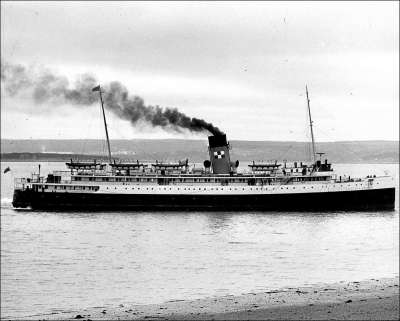
16 July 2006
Subsidies, Ferries Go Together

The Princess Helene plied the Digby-Saint John ferry
run in the 1950s. The service has operated since 1830.
Digby Nova Scotia - In 1830, The Nova Scotia
assembly offered a grant of £500 to anyone who would provide a year-round mail service between the Annapolis
Basin and Saint John, N.B., using a steamer of not less than 50 horsepower. One look at the map reveals why the assembly thought
the link was worth subsidizing. By water, the fisheries and forest industries of western Nova Scotia are only a skip from the
voracious markets of New England. By land, they are as remote as Cape Breton.
James Whitney of Saint John claimed the assembly's subsidy, and operated the mail service for 30 years - and thus began the
historic ferry service which Bay Ferries proposes to terminate at the end of October.
The most colourful period in the service's history began on 21 Feb 1849, when a newsman named Daniel Craig made his
way out in a small boat to meet the Cunard liner Europa off Halifax. Colleagues on the ship threw him a packet of European news,
and Craig raced for the shore. There he gave the packet to a waiting horseman who galloped off towards Digby.
Craig was the first bureau chief of the Associated Press outside the United States, and that horse relay from Halifax to Digby -
known as the Halifax Express - was the project that initially brought the newspaper barons of New York together to create one of
the world's greatest news-gathering organizations.
By 1849, telegraph lines had reached up the Atlantic coast as far as Saint John. Eager to get an edge in the fiercely competitive
New York market, the AP member newspapers organized a pony express. Every 12 miles, the riders blew a horn, warning stablers up
ahead to ready a fresh horse. As they pelted down the homestretch into Digby, a signalman fired a cannon, alerting a waiting ship
to send a yawl-boat ashore. With the despatches aboard, the ship steamed for Saint John, where the news was
telegraphed to New York, appearing in the local papers 35 hours before the Cunard vessel arrived.
The AP's competitors organized a similar relay, and the two sets of riders would race the whole 144 miles, covering the distance in
eight to nine hours, an average speed well over 15 miles per hour. The races lasted only a few months, until the telegraph lines
finally reached Halifax that autumn.
In the 1890s, the Dominion Atlantic Railway completed its line from Halifax to Yarmouth via Digby. In 1895, the railway acquired
the Prince Rupert, a 260-ton paddlewheeler capable of 21 knots, from Canadian Pacific. The new vessel quickly crushed
all competition on the Digby-Saint John run. Then Dominion Atlantic itself was bought by CP, which in turn ran the
Fundy service for the next eight decades.
By 1974, CP had a powerful new ferry called Princess of Acadia, but it was losing money. So CP sold the ship to the federal
government. The feds turned around and hired CP to operate the service, providing a $2 million annual subsidy. Two years later, the
government took over the ferry entirely, making it a part of CN Marine, a crown corporation which soon evolved into Marine Atlantic.
By 1997, with a gale of privatization blowing across the country, the Fundy service was acquired by Bay Ferries of Charlottetown.
But last month, Bay Ferries announced that the Fundy route was losing money, and would be shut down this autumn.
Bay Ferries president Mark MacDonald explained the decision by noting that tourism and forestry traffic had both declined, perhaps
because highway improvements in both Nova Scotia and New Brunswick have sharply cut the time it takes to drive around the Bay.
Worst of all, the price of fuel had soared. So the Princess of Acadia was no longer turning a profit.
But a closer examination reveals that Bay Ferries never truly did turn a "profit" - because it never paid the real costs
of the service. As usual, "privatization" was a sham.
Federal minister Peter MacKay recently confirmed that the feds still own the wharves at each end of the run, for which Bay Ferries
pays an annual rent of $500 each. And the company rents the ship herself - 480 feet long, 66 feet wide, with a capacity of 159 cars
and 650 passengers - for just one dollar a year. In short, "privatization" socialized the capital costs, and privatized
the profits.
Has the ferry now become unnecessary or unaffordable? The question deserves a searching, open discussion - but let's make it an
honest discussion, not a windy dispute about the legitimacy of subsidies. The Fundy ferry is an essential public service, like the
highways. Western Nova Scotia relies on it. It has always been subsidized one way or another - and still is.
And there's absolutely nothing wrong with that.
|